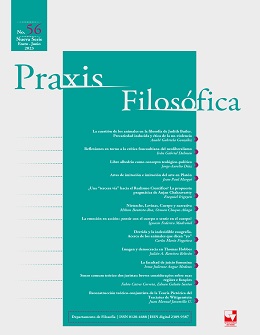Imagen y democracia en Thomas Hobbes
Contenido principal del artículo
El objetivo del presente trabajo es identificar el uso político de la imagen al servicio del Estado y la función del régimen democrático al interior del sistema filosófico de Thomas Hobbes. Tal propósito se aborda en dos momentos: I. se propone un análisis iconográfico, con lo cual se destaca una lógica de la presencia/ausencia de la multitud como un cuerpo político (i.e. problema de la dispersión); II. se retoman las discusiones en torno a la función de la democracia, y se expone el problema de la dispersión como el paso de la multitud disuelta al pueblo junto a la consolidación del cuerpo soberano (i.e. régimen democrático). Se concluye que el uso político de la imagen, descrita a partir de la distinción entre la adoración civil y la adoración divina, por parte del poder soberano, es una exhortación hobbesiana a la regulación del miedo (ciu bono del sostenimiento del poder soberano). En consecuencia, el gobierno de la imagen implica el problema del régimen democrático.
- Imagen
- democracia
- Potentiae
- Potestas
- representación
Agamben, G. (2017). Stasis. La guerra civil como paradigma político. Homo sacer, II. Adriana Hidalgo editora.
Brandt, R. (1982). Das Titelblatt des Leviathan und Goyas EI Gigante. En U. Bernmbach y K. M. Kodalle (Eds.), Furcht und Freiheit. LEVIATHAN- Diskussion 300 Jahre nach Thomas Hobbes (pp. 203-231). Westdeutscher Verlag. https://doi.org/10.1007/978-3-322-94334-7_15
Bredekamp, H. (2003). Stratégies visuelles de Thomas Hobbes: Le Léviathan, archétype de l’État moderne: Illustrations des oeuvres et portraits. Les Editions de la MSH.
Bredekamp, H. (2007). Thomas Hobbes’s Visual Strategies. En P. Springborg (Ed.), The Cambridge companion to Hobbes´s Leviathan (pp. 29-60). Cambridge University Press. https://doi.org/10.1017/CCOL0521836670.002
Brito Vieira, M. (2009). The Elements of Representation in Hobbes. Aesthetics, Theatre, Law, and Theology in the Construction of Hobbes's Theory of the State. Brill.
Cardoso dos Santos, A. G. (2021). O dilema da escolástica: A crítica hobbesiana à teoria escolástica e à fundamentação do poder papal no frontispício do Leviatã. Ponencia presentada en el VII Congresso Internacional Thomas Hobbes.
Champion, J. (2016). Decoding the Leviathan: Doing the History of Ideas through Images, 1651–1714. En M. Hunter (Ed.), Printed Images in Early Modern Britain: Essays in Interpretation (pp. 255-275). Routledge.
Collins, J. R. (2005). The Allegiance of Thomas Hobbes. Oxford University Press.
de Covarrubias Orozco, S. (1610). Emblemas morales. Biblioteca Nacional de España. http://bdh-rd.bne.es/viewer.vm?id=0000108144&page=1
Fernández Peychaux, D. (2018a). Un campanario que sostenga el cielo. En C. Abdo Férez, D. Fernández Peychaux y G. Rodríguez Rial (Comps.), Hobbes, el hereje: teología, política y materialismo (pp. 37-60). Eudeba.
Fernández Peychaux, D. (2018b). The Multitude in the Mirror: Hobbes on Power, Rhetoric, and Materialism. Theory & Event, 21(3), 652-672.
Field, S. L. (2020). Potentia: Hobbes and Spinoza on power and popular politics. Oxford University Press.
Frost, S. (2008). Lessons From a Materialist Thinker: Hobbesian Reflections on Ethics and Politics. Stanford University Press. https://doi.org/10.1515/9781503626836
Ginzburg, C. (2018). Miedo, Reverencia, Terror: Releer a Hobbes hoy. Cinco Ensayos de Iconografía Política. Contrahistorias.
Hobbes, T. [EW]. (1845). Answer to Sir William Davenant's Preface before “Gondibert” [1651]. En J. Bohn, H. Street, y C. Garden (Eds.), The English Works of Thomas Hobbes of Malmesbury, [Vol. 4]. C. Richards, Printer, St, Martin’s Lane.
Hobbes, T. (1928). The Elements of Natural Law, Natural and Politic (F. Tönnie, Ed.). Cambridge University Press.
Hobbes, T. [DM]. (1973). Critique du De mundo de Thomas White. Vrin-Cnrs.
Hobbes, T. [CV]. (1993). El ciudadano. (J. Rodríguez Feo, Ed.). Debate.
Hobbes, T. [L]. (2019). Leviatán. (C. Balzi, Ed.). Colihue Clásica.
Kristiansson, M. y Tralau, J. (2013). Hobbes’s hidden monster: A new interpretation of the frontispiece of Leviathan. European Journal of Political Theory, 13(3), 299-320. https://doi.org/10.1177/1474885113491954
Limongi, M. I. (2009). Direito e Poder: Hobbes e a dissolução do Estado. DoisPontos, 6(3), 181-193. http://dx.doi.org/10.5380/dp.v6i3.14675
Limongi, M. I. (2013). Potentia e potestas no Leviathan de Hobbes. DoisPontos 10(1), 143-166. http://dx.doi.org/10.5380/dp.v10i1.32128
Malcolm, N. (2002). Aspects of Hobbes. Oxford University Press. https://doi.org/10.1093/0199247145.001.0001
Martel, J. (2007). Subverting the Leviathan: Reading Thomas Hobbes as a Radical Democrat. Columbia University Press. https://doi.org/10.7312/mart13984
Matheron, A. (1997). The theoretical function of democracy in Spinoza and Hobbes. En W. Montag, y T. Stolze (Eds.), The New Spinoza (Theory Out of Bounds) (pp. 207-218). University of Minnesota Montag.
Pacchi, A. (2022). Escritos hobbesianos (1978-1990). Eudeba.
Pitkin, H. (1967). The Concept of Representation. University of California Press.
Plata Pineda, O. (2006). Religión y política en el Leviatán de Thomas Hobbes. Praxis Filosófica, (23), 57-80. https://doi.org/10.25100/pfilosofica.v0i23.3124
Schmitt, C. (1990). El Leviathan: en la teoría del Estado de Tomás Hobbes. Struhart & Cía.
Skinner, Q. (1996). Reason and Rhetoric in the Philosophy of Hobbes. Cambridge University Press. https://doi.org/10.1017/CBO9780511598579
Skinner, Q. (2010). Hobbes y la libertad republicana. Universidad de Quilmes/Prometeo.
Skinner, Q. (2018). From Humanism to Hobbes. Studies in Rhetoric and Politics. Cambridge University Press. https://doi.org/10.1017/9781316415559
Springborg, P. (1975). Leviathan and the Problem of Ecclesiastical Authority. Political Theory, 3(3), 289-303. https://doi.org/10.1177/009059177500300305
Springborg, P. (1995). Hobbes’s Biblical Beasts: Leviathan and Behemoth. Political Theory, 23(2), 353-375. https://doi.org/10.1177/0090591795023002008
Tralau, J. (2013). Deception, politics and aesthetics. The importance of Hobbes’s concept of metaphor. Contemporary Political Theory, 13(2), 112-129. https://doi.org/10.1057/cpt.2013.18
Tuck, R. (2006). Hobbes and Democracy. En A. Brett, J. Tully, y H. Hamilton-Bleakley (Eds.), Rethinking the Foundations of Modern Political Thought (pp. 171-190). Cambridge University Press. https://doi.org/10.1017/CBO9780511618376.011
Tuck, R. (2016). The Sleeping Sovereign. The Invention of Modern Democracy. Cambridge University Press. https://doi.org/10.1017/CBO9781316417782
Descargas
Aceptado 2023-03-07
Publicado 2023-04-20

Esta obra está bajo una licencia internacional Creative Commons Atribución-NoComercial-SinDerivadas 4.0.
De acuerdo con nuestra política (Licencia Creative Commons CC BY-NC-SA 4.0) los artículos presentados y sometidos al proceso editorial en la revista Praxis Filosófica no tienen costo alguno para sus autores ni retribuciones económicas para la revista. El artículo de carácter inédito, producto de investigación o de algún proyecto que se presente a Praxis Filosófica, no podrá estar sometido a otro proceso de publicación durante el proceso que se lleve en nuestra revista.





